Wilbur Stout's References:
Bureau of Labor Statistics, 1887, page 46-51.
Geological Survey of Ohio, Vol. V. 1884, page 458.
History of the Hanging Rock Iron Region, 1916. Willard, Williams,
Newman and Taylor. Vol. 1 pages 265, 266, 600-601.
The Portsmouth Inquirer, Friday, Jan. 7, 1853.
Personal Letter, John Bancroft, Sr. Wilmington, Delaware. May 2, 1933.
Notes by Nan B. Akin, Columbus, Ohio. 1933.
"A Century of Ironmaking in Southern Ohio." John D. Knox. The Iron
Trade Review, Sept. 30, 1920, page 924.
Iron Manufacturer's Guide. J. P. Lesley, 1859, page 114.
Vinton Furnace - Coal
by Wilbur Stout
With the advent of coal as a metallurigical fuel
the old charcoal furnaces were gradually forced to give way to the newer,
then more modern, stacks. Many of the original sites, however, offered
advantages of ore, limestone, coal, transportation, houses, etc. favorable
for the erection of furnaces using either coal or coke for the fuel of
the burden. Vinton was one of several sites where the charcoal furnace
was succeeded by a coal furnace. This was accomplished by Bancroft and
Rader who under the name of Vinton Coal and Iron Company took over the
Vinton furnace property and in November, 1873, went to work to erect a
modern plant at the side of the original charcoal stack.
Thomas B. Bancroft, who was the financial part of
the firm and who did not take a direct part in the management of the furnace,
was in the anthracite coal business at Schuyler, Nelson County, Virginia.
He staked his capital against Rader's knowledge. Charles Innis Rader was
educated in metallurgy in Freiburg, Germany. He came to this country and
almost immediately afterwards formed the partnership with Bancroft and
went to Vinton County to erect the new furnace and the coke ovens. He was
well educated and an accomplished musician. On leaving 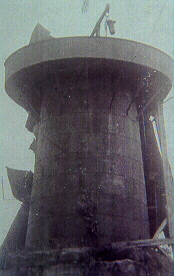 Vinton
County about 1880 he went to Sharon, Pennsylvania and there took charge
of furnaces owned by Mr. Kimberly.
Vinton
County about 1880 he went to Sharon, Pennsylvania and there took charge
of furnaces owned by Mr. Kimberly.
For that time the new Vinton furnace, under the
name of Vinton Coal and Iron Company, was modern in every respect. It had
a steel jacket, was water cooled, had special devices for charging and
casting, and had efficient hot blast stoves. This stack was 50 feet in
height by 11 feet in diameter at the boshes. The rated capacity was 20
tons of metal per day or 6,000 tons per year.
Bancroft and Rader first attempted to use raw Quakertown
coal as the fuel. This was taken from a shaft 130 feet in depth and located
near the school about one-fourth miles north-west of the furnace. Thus
burdened the furnace was not a success. The failure was due not so much
to the content of sulphur and ash as to the rapidity of burning of the
fuel. The analysis of the coal is given below:
|
Thickness |
Moisture |
Volatile
Matter |
Fixed
Carbon |
Ash |
Sulphur |
| Upper bench |
1ft. 3 in. |
4.90 |
30.70 |
57.80 |
6.60 |
.65 |
| Lower bench |
1ft. 4 in. |
4.60 |
29.00 |
55.80 |
10.60 |
1.30 |
The next attempt was to coke the Clarion coal found
in good thickness near the furnace in a battery of Belgian ovens. The coal
coked readily, gave a yield of about 56 per cent, and produced a product
with excellent strength and structure but with a content of sulphur prohibitive
for metallurgical purposes. Where mined the Clarion coal had the following
structure:
| Shale |
gray, with small ore nodules |
15' |
| Coal |
fair |
1' 2" |
| Shale |
|
1/2" |
| Coal |
bony |
1 1/2" |
| Clay |
dark |
4" |
| Coal |
good Clarion |
1' 6" |
| Clay |
with pyrite |
1" |
| Coal |
good |
1' 2" |
| Clay |
siliceous |
10" |
| Coal |
good |
1' 2" |
| Clay |
siliceous |
1' |
The analysis of this coal is approximated by that
of another sample taken not far distant. The results are given below:
| Moisture |
4.80 |
| Volatile Matter |
40.56 |
| Fixed carbon |
42.21 |
| Ash |
15.43 |
|
Total
|
100.00 |
| Sulphur |
3.51 |
For coking purposes the battery consisted of 24 ovens,
each 2 feet 6 inches wide, 24 feet 3 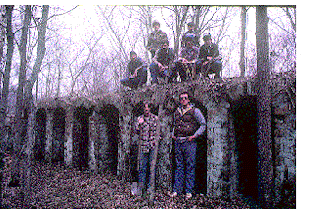 inches
long, 5 feet 10 inches high to spring at arch, and 9 inch rise in arch.
The walls between the separate ovens were 1 foot 4 inches thick. The brick
for the ovens were shipped direct from Belgium and were 13 inches long
by 4 1.2 inches wide by 4 inches thick. Special arch and skew brick were
used in the roof. The failure of the enterprise was not through the furnace
or the coke oven, but through the high sulphur content of the coal.
inches
long, 5 feet 10 inches high to spring at arch, and 9 inch rise in arch.
The walls between the separate ovens were 1 foot 4 inches thick. The brick
for the ovens were shipped direct from Belgium and were 13 inches long
by 4 1.2 inches wide by 4 inches thick. Special arch and skew brick were
used in the roof. The failure of the enterprise was not through the furnace
or the coke oven, but through the high sulphur content of the coal.
After this experience the furnace was run for a
few years on coal shipped from near Athens in the Hocking Valley. The company
brought a car load of raw emigrants from Ellis Island, mainly Germans and
Poles, to work at the furnace and in the mines. In much of the work the
women worked side by side with the men. the furnace ran until 1879 or 1800
when the Vinton Coal and Iron Company was caught in the crash of Jay Cook
and in the panic that followed. Soon afterward the works were dismantled
and the place practically abandoned.
References:
Wilbur Stout's References:
Bureau of Labor Statistics, 1887, page 46-51.
Geological Survey of Ohio, Vol. V. 1884, page 458.
Personal Letter, John Bancroft, Sr. Wilmington, Delaware. May 2, 1933.
Notes by Nan B. Akin, Columbus, Ohio. June 22, 1933.
Directory to the Iron and Steel Works of the United States, The
American Iron and Steel Association. 1884, page 56.
Belgian Ovens Coke Plant
BELGIAN COKE PLANT EXPERIMENT
by The Olde Forester, Emmett A. Conway
In a second beginning the new owners of The Vinton Coal
and Iron Company southeast of McArthur, Ohio, hired Charles Innes Rader
to modernize and operate the 1853-54 stone charcoal blast furnace. Rader
had studied mining and metallurgy at Freiburg University, Germany,
and was, no doubt, learned in all the latest innovations in Europe.
The Olde Forester visited Freiburg University in 1978 and confirmed
that they did, indeed, teach mining and metallurgy c1850 but no longer.
A forest policy professor confirmed this after an investigation.
We learned at the small Black Forest village of Waldkirck from a farmer
living in a 350 year old BARNHAUS that “there had been iron blast furnaces
in Waldkirck, but only the streets remember.” We would-be historians
cherish that comment.
The Vinton Furnace managers have met with, what must have been,
bitter disappointment with the coke produced by the Belgian Ovens.
James G. McKitterick, in a Report on the Mineral Potential of Vinton Furnace
Tract in 1945 for a potential timber buyer, stated that the “hill coal’
(Clarion No. 4a) was too high in sulfur for use in the blast furnace. No
other coal on the property was suitable either.
McKitterick, in his comprehensive report, and as can be seen today
from observations, used the expensive ovens for roasting the raw ore. Ore
covers the floors of the chambers.
We searched for some of the coal coke and found small piles under
the many layers of leaves. The coke is firm.
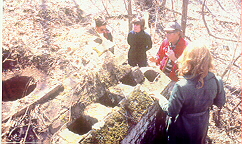 In 1997 we examined
the Belgian Oven remains with John Scurlock. John was an old friend who
had supervised the building of modern coke plants at McNally Pittsburg
plant in Wellston, Ohio. “Tricks of the trade, and a coke plant maker is
made”, would have been a statement of Homer as often said in THE ILIAD.
Unfortunately, John passed away in February, 1998.
In 1997 we examined
the Belgian Oven remains with John Scurlock. John was an old friend who
had supervised the building of modern coke plants at McNally Pittsburg
plant in Wellston, Ohio. “Tricks of the trade, and a coke plant maker is
made”, would have been a statement of Homer as often said in THE ILIAD.
Unfortunately, John passed away in February, 1998.
John Scurlock’s observations are as follows with reference to
a 1875 news article which appeared when the coke plant first opened. The
news
article is reprinted below:
1. The pushing engine would have been powered by steam and moved
on transfer tracks as needed -- much the same as modern coke plants.
2. There is a space between the ovens and a pile of decomposed
material, presumably washed coal as described in the 1875 news article.
The space is about 24 feet wide, not measured. Under this transfer
pusher area there might be remains of cross ties or stringers and, perhaps,
some dropped metal; but it doesn't appear that the salvagers left anything
behind.
3. Grooves for the door pintles show on each chamber opening.
4. Air for combustion appears to have been provided by two
two inch openings on each side of a door. I noted that a hole
leads from these main ducts into the combustion flues. These appear to
be about a half inch in diameter.
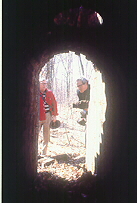 5. Two
charging holes appear on top for each oven. The top is covered with
vegetation and is probably a sunning place for snakes, copperheads, rattlesnakes,
etc.
5. Two
charging holes appear on top for each oven. The top is covered with
vegetation and is probably a sunning place for snakes, copperheads, rattlesnakes,
etc.
6. A bulwark supports the north end at the edge of the drop off.
Collapsed or unfinished ovens lie in piles on the south.
7. The ovens are a masterpiece of ceramics. Each oven is
a replica of the others. We don't know how many individual patterns
were required but there are arch parts, angles, tees, v’s, and circles
for the charging holes.
8. A controversy exists about whether the oven bricks were made
in Belgium or in the US
A. Robert Vogel, Smithsonian engineer retired said upon examination,
that they would have been of domestic manufacture. Richard Conway, ceramic
engineer, agreed. James McKitterick, in his report to Mr. Frampton,
said they were made abroad. McKitterick was a careful researcher
.
NEWSPAPER ARTICLE FROM NOVEMBER
17, 1875
The following is excerpts from an article appearing in the McArthur
Enquirer dated November 17, 1875. The article has been edited and reporduced
by Richard H. Leive.
Operation at the Vinton Coke Oven Site
Our readers will remember that in May last we noticed, in these columns,
the preparation being made by Messrs. Bancroft & Rader, proprietors
of the Vinton Furnace, for converting coal into coke. At that time,
Mr. Charles I. Rader was superintending the construction of a small
oven for the purpose of experimenting with the hill coal on the lands of
the Vinton Furnace & Coal Co. By the process in that oven, a
very excellent quality of coke was produced. It was then resolved
to go into the manufacture of coke on a larger scale...to manufacture a
sufficient quantity required for the use in the furnace.
The erection of a building 50 feet high, 62 feet long, and 32 feet wide
in which to place an engine and machinery took place. The construction
of 24 ovens on a site just south of the furnace stack was started together
with the excavation of ground in preparation for the laying of a pavement
of firebrick 40 by 100 feet on which coke from the ovens would be discharged.
On the opposite side of the oven battery, a track was laid upon which to
operate a coke pushing engine. All of that was completed over a month
ago, when the engine and machinery were set up, and everything made ready
for operation.
A 30 horse power engine was furnished by the Portsmouth Foundry &
Machine Co. at a cost of $1,400. One of H. Bradford's Coal and Ore
Separators was provided by Carter, Allen & Co. of Tomaqua, PA at a
cost of $6,000. The Jigger and Separator were placed in perfect running
order by William Leckie, a gentleman from Philadelphia, sent by the Patentee.
There are two methods of manufacture of coke in use...one in ovens,
and the other in large open heaps on the ground. The twenty-four
ovens built by Messrs. Bancroft & Rader are more durable and far superior
in every respect to any ever built in this or in the old world countries.
They are known as "J. King McClananan's Improved Coke Ovens," and are an
improvement on the "Belgian type" of coke ovens.
Messrs. Bamcroft & Rader, two of the most energetic iron manufacturers
in Ohio, notwithstanding the distressing conditions of money market of
the country, have already spent over $46,000 in the enterprise.
The ovens are built with Webster Firebrick, arranged together in one
stack, each oven being 22 feet long, 6 feet high and arched over the top,
and 2 1/2 feet wide, covering an area of 22 by 100 feet. The two
outside ovens are supported by substantial stone abutments. There
are 20 down flues to each oven and 4 up flues leading to a chimney.
The 30 down flues lead to the 4 up flues, which connect with the chimney,
8 feet high, on each oven. The gas from the coal enters the down
flues, passes around and under the bottom and through the up flues to the
chimneys, thereby completely surrounding the coal to be coked with hot
sides and bottom. The charge of coal is 5 1/2 feet in thickness,
or about 180 bushels, and the time consumed in the coking process occupies
about 48 hours. At both ends of each oven are very heave iron doors
lined with fire clay. When the coal is charged, those doors are closed
and thoroughly luted with common or yellow clay to prevent the access of
any air whatever. When the coke is ready to be drawn, the iron doors
are opened, and a powerful pushing engine is immediately run in front of
the open oven and the plug of coke is discharged to the opposite side where
it is immediately quenched by a stream of water. The water, besides
preventing combustion, eliminates a considerable amount of sulphur. The
coke is now ready for use in the furnace and is filled in iron barrows
or buggies and run directly to the tunnel head to be charged into the furnace.
The coal used by Messrs. Bancroft & Rader is of the hill vein, commonly
known as the limestone vein of coal. It is mined by drifting, the
mouth of the drift being only 200 yards from the furnace stack or from
the coal separator. The quantity of coal in that hiss alone is said
to be sufficient to supply the wants of the furnace for twenty years.
The coal, as it comes from the mine, is dumped over screen bars into a
large hopper. Pieces too large to pass through the screen are broken
so that no piece will exceed 4 inches square is size. From that hopper,
the coal is fed to a set of toothed rollers which crush it to a size not
to exceed 1/2 inch square. The coal from these rollers then passes
through a small hopper beneath, from where it is taken by elevator buckets
and carried to a distance of 50 feet in height where it is delivered to
a revolving screen. All pieces too large to pass through the screen
are returned, by means of a chute, to a second set of rollers which crushes
it to the required size and delivers it to the same set of elevators as
before described. The coal, as it passes through the screen, becomes
assorted and is then delivered to jigs or separators, which have an up
and down motion in water of 200 strokes per minute. The bottom of
the jigs or separators consist of perforated sheets of iron with openings
not larger than 1/2 inch square. The motion of the jigs in water
keeps the coal in constant suspension and the specific gravity of the coal,
being lighter than that of slate or sulphur, the coal passes over and into
a hopper from which it is elevated and delivered to two bins of 100 tons
capacity each. Under the bins is a continuation of the small railroad
track leading to the top of the ovens. On the bottom of each bin
are two gates, under which gates hopper cars are placed to receive the
supplies of coal for charging the ovens. The slate and sulphur, being
heavier than the coal, falls through the perforated sheets of the jig and
passes through another hopper when it is taken to the slate elevator and
delivered to the "waste pile."
Inside the building, only four men are required to operate the machinery,
viz: one engineer, who is his own fireman, and who operates the coke
pushing engine when the coke is ready to be pushed out of the ovens; one
weigher of coal who prepares it for dumping into the chute; one feeder;
and one assorter who removes large pieces of slate, sulphur, etc.
Outside the building, five men are also employed, viz: two to charge
the ovens; two to attend the opening and closing of the iron doors; and
one to water and remove the coke.
The works are eligibly located near the furnace. A railroad of
two miles in length runs to the M & C Railroad at Vinton Station, which
enables the Furnace Company to ship their iron or to ship coke to any part
of the country.
|
The following is a copy of a newspaper report dated 11/25/1875 which
Lawrence McWhorter, Hamden, OH, found in the Democratic Inquirer
archives. He recognized its historical importance in the Iron Industry
of The Hanging Rock Iron Region.
The article was written at the opening of the coke plant and at the
time the new process was thought to be successful. Unfortunately, the local
coal proved to be too high in sulphur content and couldn't be used.
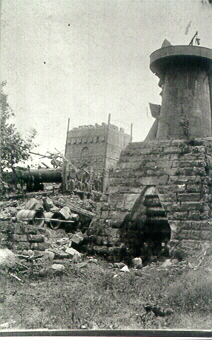
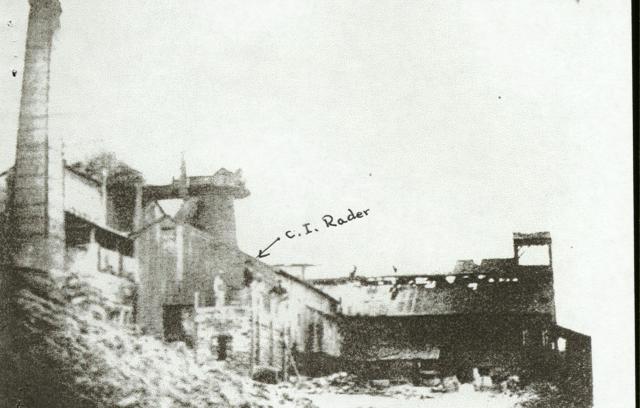
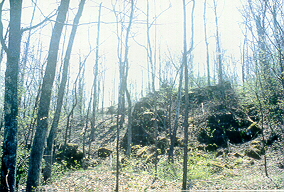
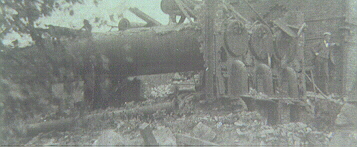 with hot or
cold blast. The furnace had switch connections to the Marietta and Cincinnati
Railroad.
with hot or
cold blast. The furnace had switch connections to the Marietta and Cincinnati
Railroad.
 Vinton
County about 1880 he went to Sharon, Pennsylvania and there took charge
of furnaces owned by Mr. Kimberly.
Vinton
County about 1880 he went to Sharon, Pennsylvania and there took charge
of furnaces owned by Mr. Kimberly.
 inches
long, 5 feet 10 inches high to spring at arch, and 9 inch rise in arch.
The walls between the separate ovens were 1 foot 4 inches thick. The brick
for the ovens were shipped direct from Belgium and were 13 inches long
by 4 1.2 inches wide by 4 inches thick. Special arch and skew brick were
used in the roof. The failure of the enterprise was not through the furnace
or the coke oven, but through the high sulphur content of the coal.
inches
long, 5 feet 10 inches high to spring at arch, and 9 inch rise in arch.
The walls between the separate ovens were 1 foot 4 inches thick. The brick
for the ovens were shipped direct from Belgium and were 13 inches long
by 4 1.2 inches wide by 4 inches thick. Special arch and skew brick were
used in the roof. The failure of the enterprise was not through the furnace
or the coke oven, but through the high sulphur content of the coal.
 In 1997 we examined
the Belgian Oven remains with John Scurlock. John was an old friend who
had supervised the building of modern coke plants at McNally Pittsburg
plant in Wellston, Ohio. “Tricks of the trade, and a coke plant maker is
made”, would have been a statement of Homer as often said in THE ILIAD.
Unfortunately, John passed away in February, 1998.
In 1997 we examined
the Belgian Oven remains with John Scurlock. John was an old friend who
had supervised the building of modern coke plants at McNally Pittsburg
plant in Wellston, Ohio. “Tricks of the trade, and a coke plant maker is
made”, would have been a statement of Homer as often said in THE ILIAD.
Unfortunately, John passed away in February, 1998.
 5. Two
charging holes appear on top for each oven. The top is covered with
vegetation and is probably a sunning place for snakes, copperheads, rattlesnakes,
etc.
5. Two
charging holes appear on top for each oven. The top is covered with
vegetation and is probably a sunning place for snakes, copperheads, rattlesnakes,
etc.